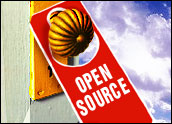New York-based Xandros this week began shipping its Linux-based Xandros Business Desktop and Operating System, an enterprise Windows desktop replacement that the company says is completely compatible with Microsoft Windows servers.
The software — priced at US$129 per copy or $500 for a five-license pack — aims to provide a secure, plug-in replacement of “costly” Windows desktops.
Some view Xandros as a smaller, less significant player that is likely to have success only in a niche of the market while larger players such as Sun, SuSE-Novell and Red Hat play a larger role in Linux on the corporate desktop. Even as Xandros rolled out its new Windows-ready Linux this week, there were reports that computing giant HP might be offering Linux-powered PCs in Asia.
Regardless of vendor, though, Yankee Group senior analyst Dana Gardner said a confluence of factors — as well as interoperability improvements — is making Linux on the desktop look better than ever.
“There’ve been several companies out there pushing Linux on the desktop,” Gardner told LinuxInsider. “While Windows is still dominating, the opportunity appears to be growing for enterprises to try and save some money and simplify, particularly in certain instances where there’s a type of user with limited application needs.”
Competing on Compatibility
“It seems the technological stars and planets have aligned in terms of putting issues to rest,” Gardner added. “Concerns about security and cost are making people more open to examining alternatives than they were before.”
Xandros said its new Business Desktop OS — featuring authentication against Windows primary domain controllers (PDCs) and Active Directory services — is the first in the Linux market to deliver seamless compatibility in a secure, plug-in replacement for Windows operating systems.
With support for domain controller user profiles and group policy logon scripts, the software is designed to ease the process of migrating to Linux. Xandros said the operating system has built-in compatibility with MS Office, StarOffice 7, Windows file sharing, symmetric multiprocessing and hyperthreading.
“Our extensive cross-platform networking and program compatibilities enable desktop-driven businesses such as financial or insurance firms to easily migrate to Linux,” said Xandros chairman and CTO Frederick Berenstein.
Enterprise Class Questioned
Harvard Research Group vice president of Linux strategy Bill Claybrook, however, questioned Xandros in the enterprise while players such as Sun, SuSE and Red Hat also are looking to move Linux onto the corporate desktop.
“If Linux becomes big on the desktop, it’s not going to do so because of Xandros,” Claybrook told LinuxInsider. “I just don’t see it as an enterprise-quality product.”
Claybrook indicated that the Xandros OS, which he described as “a pretty cool product,” might play better with consumers — where big vendors such as Sun, SuSE, Red Hat and HP are “not really doing anything.” He noted that, unlike Sun and SuSE, Xandros has not been able to announce a major deal.
Big Endorsement Needed
The Yankee Group’s Gardner said that while Sun, SuSE-Novell and Red Hat are mostly concentrating their Linux strategies on servers, there might be room for a more aggressive desktop move from a company such as Xandros.
The analyst said there are two main Linux markets: overseas, where there is “more of a herd mentality toward non-Windows environments,” and the U.S. and North American markets, in which users who are not “application needy” present a growth opportunity for Linux.
However, Gardner agreed that one piece of the puzzle that is still missing is Xandros getting a big company to switch to Linux on the desktop. “There’s going to need to be a period where word gets out,” he said. “When a big client with 2,000 or 3,000 seats switches and says, ‘We did it, it worked, it saved us money,’ — that will be useful.”
Not Afraid To Compete
Xandros CTO Berenstein, who alluded to the security and stability issues associated with Windows, in addition to higher purchase prices, told LinuxInsider that its roots in Corel Linux integration make Xandros the only truly viable desktop replacement for Windows.
“Creating an alternate desktop is the easy part,” Berenstein said. “The biggest challenge is to provide a migration path from proprietary to open source through seamless integration with Microsoft’s applications and networks.”
As far as his larger Linux competitors, Berenstein said each has something to offer, but none has a comprehensive desktop-to-enterprise strategy.
“Red Hat has left the desktop market in favor of the enterprise, and SuSE is just beginning to take the desktop seriously,” Berenstein said. “Although a much larger company, they did not offer MS Office compatibility until nine months after Xandros did. Sun also seems to just be at the beginning of developing an overall strategy for being a Linux company rather than a Sparc-Solaris company.
“I’d say try them all and go with the best,” Berenstein added. “We’re not afraid to compete.”








































